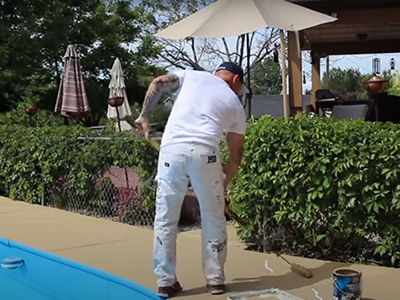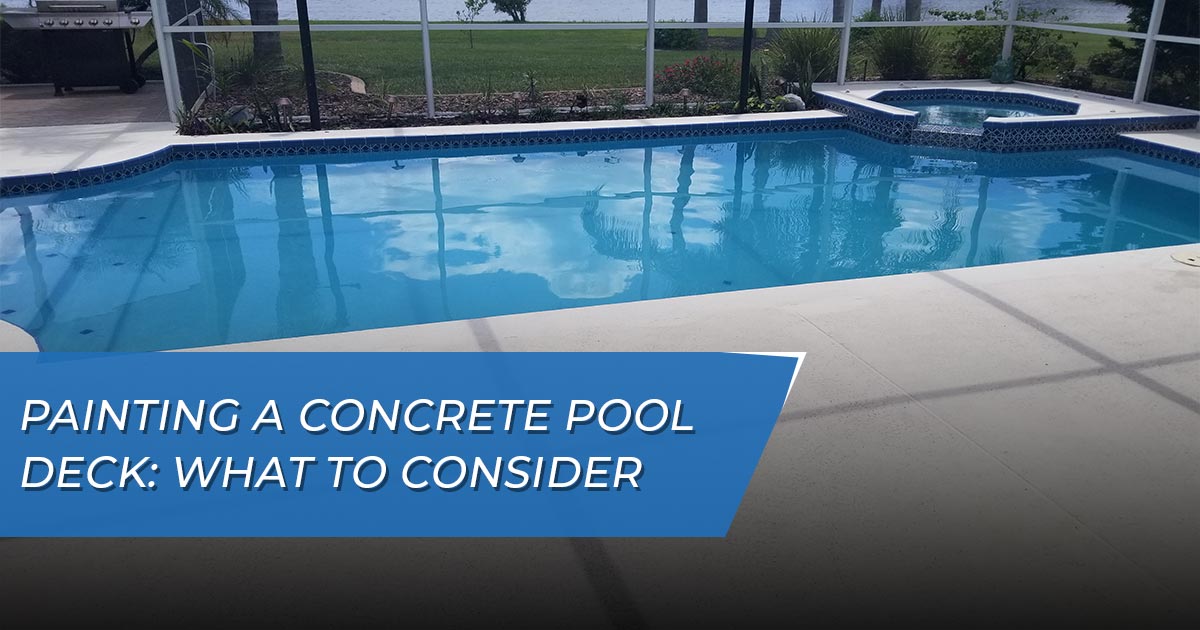Painting a Concrete Pool Deck: What to Consider
Letting your concrete pool deck become chipped or cracked isn’t just a matter of aesthetics. It also poses a safety hazard since the chance of slipping and falling increases significantly. Painting the concrete surface doesn’t just improve the appearance of the deck around the pool, it can also improve its safety and keep it from becoming more damaged in the future. Concrete is a tough material, yet it still benefits from the protection offered by the right kind of paint and sealant. Find out what steps go into preparing and painting a pool deck of this kind to decide which forms of pool remodeling will work best for your situation.
Related Article: Pool Decking Options for Your Renovation Project
Why Choose to Paint?
 Many concrete pool decks aren’t painted from the start, but rather left uncovered from the start or coated only with a clear sealant product. This is especially true for concrete structures if special aggregates like rounded pebbles are chosen for their appearance. Over time, exposure to the sun, rain, and chlorine from the pool’s water will lead any deck material to break down. Concrete surfaces need protective coatings to keep the elements from causing cracking, splitting, and spalling. Painting is a good choice that allows you to alter the appearance of the surface while preserving it for years to come.
Many concrete pool decks aren’t painted from the start, but rather left uncovered from the start or coated only with a clear sealant product. This is especially true for concrete structures if special aggregates like rounded pebbles are chosen for their appearance. Over time, exposure to the sun, rain, and chlorine from the pool’s water will lead any deck material to break down. Concrete surfaces need protective coatings to keep the elements from causing cracking, splitting, and spalling. Painting is a good choice that allows you to alter the appearance of the surface while preserving it for years to come.
Painting can be part of a larger resurfacing and remodeling project or just taken on alone to prevent the need for further treatment. Not just any old exterior paint will work for this job due to the need for a tight bond to the concrete surface, so water doesn’t get between the layers. It’s equally important to select the right primer and prepare the surface extensively to prevent bonding issues. While coating the concrete deck in this way may take plenty of preparation and proper painting practices, it’s worth the effort to preserve the material and reduce the need for more extensive repairs.
Prep for Painting a Concrete Pool Deck
Cleaning and preparing the surface are the first steps and the most important part of the process. This part of the process can take hours, even with the right equipment, or days if you try to do it yourself. Any damage like cracks or splitting needs to be dealt with before any patching can be done. Check for crumbling material, bits of aggregate loose from the surface, and even fine cracks. There are patching materials for each problem with it, resulting in a solid and whole deck to start coating with the right primer and then painting.
Stable and intact pool decks with no particular damage will still need thorough cleaning and degreasing. This removes any residues that might interfere with the tight bond between the new coating of paint and the original material. All concrete decks need to be etched for this purpose after repairs and cleaning are completed. Various acid products are recommended for this process, but they need to be applied with care to reduce the potential for damage. After etching, the primer should bond tightly to the deck. This reduces the potential for issues with paint peeling or bubbling after application.
Related Article: Pool Deck Pavers vs Concrete: How Do They Compare?
Selecting Pool Deck Paint and Primers
 The primer must go down first to prepare the top of the deck for paint. Without priming, the paint won’t coat the concrete as well and may develop bonding issues. The primer needs to cover the entire surface and get a chance to dry fully before being covered with the paint. Pool remodeling should be completed, and all epoxy products allowed to cure before priming begins. Applying this coat too early in the repair process will only lead to issues in the long run. Rain and other forms of moisture are often fine when they occur in the midst of the process, but you may need to extend the curing time frame afterward to compensate. Choosing professional painting will eliminate the need for you to be personally concerned about drying or curing times, providing superior results.
The primer must go down first to prepare the top of the deck for paint. Without priming, the paint won’t coat the concrete as well and may develop bonding issues. The primer needs to cover the entire surface and get a chance to dry fully before being covered with the paint. Pool remodeling should be completed, and all epoxy products allowed to cure before priming begins. Applying this coat too early in the repair process will only lead to issues in the long run. Rain and other forms of moisture are often fine when they occur in the midst of the process, but you may need to extend the curing time frame afterward to compensate. Choosing professional painting will eliminate the need for you to be personally concerned about drying or curing times, providing superior results.
After priming, it is time to finally paint the concrete deck. Paint spraying is most commonly recommended for both priming and painting since it evenly coats the roughest surfaces with a thick coating. This ensures even drying and reduces the need for touch-ups with a hand brush around fixtures and other parts of the pool’s systems. Some surfaces will inevitably need more hand application of paint to get good coverage. Many concrete coating products only need a single coat to properly protect the material for years to come, while others work best when applied in multiple thinner coats.
Related Article: 7 Signs It’s Time For Pool Deck Renovation
Sealing the Painted Pool Deck
The remodeling process for a pool deck doesn’t end with painting. When the paint gets a chance to dry fully, it’s time for sealing. Sealants are clear coating products sprayed or rolled on at the very end of the process. These sealants protect the paint and the surface below it from the wear and tear caused by the elements. If you want to keep the painted deck protected, have this sealant reapplied regularly to maintain the layer. Don’t let the sun or water reach the paint, much less the concrete below if you want your remodeling efforts to last for years to come. There are a number of sealants to match the type of paint and the surface texture for the best possible results.
GPS Pools is your reliable source for all the pool deck resurfacing and remodeling services you need, including concrete deck painting. Let us determine how much work your pool needs to look brand new. We can put together a custom package of upgrades for any budget and your design preferences. Contact our team of pool experts at one of our locations in New Tampa, Land O’Lakes, or Lutz for a full overhaul to help keep your swimming space in a good place for years to come, including the deck around the water’s edge, regardless of the materials used to construct it.

